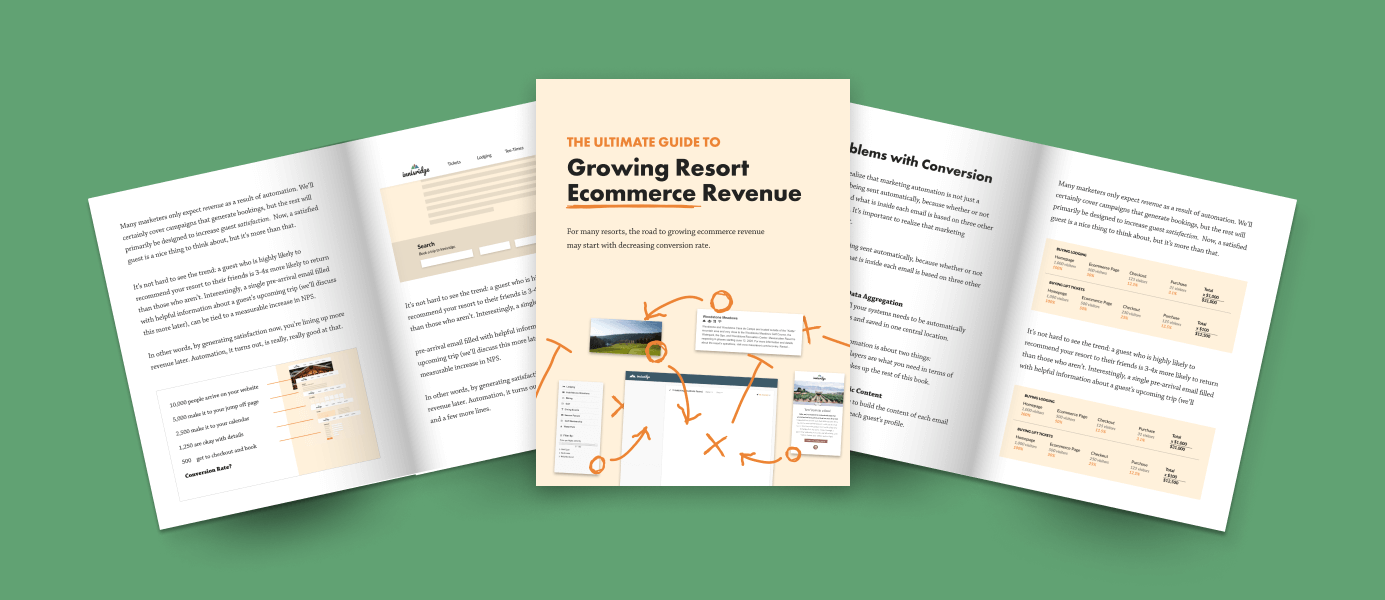
Tips

This is an excerpt from our upcoming book, The Ultimate Guide to Growing Resort Ecommerce Revenue. Click here to download a preview→
Ask a marketer what impacts conversion rate and they’ll likely point to the design of their booking engine. If only they could change the button color or listing style or form length or how certain links work they’d be able to ratchet that number up a little. But that’s like blaming my Nikes for the pathetic time I ran in that Independence Day 10k.
Yes, shoes (or form length) can absolutely help, but it’s one of many factors that go into my overall performance. Just like my 10k time was a combination of my training, preparation, genes, course design, and the day’s weather, the same is true for your conversion rate. One thing can move it up or down, but it’s a combination of many factors that ultimately leads to what your conversion rate looks like day-to-day. There are dozens of ways to group these factors, but here are seven simple buckets to consider.
The first, and most significant, are the products you sell. Depending on how you measure (see the Introduction to this book), the average conversion rate of a full price, luxury hotel room may be 1%. But keep everything in the booking engine constant and swap the product sold for a bike rental and you may see the conversion rate jump 10x or more. On the low end you’ll see packages, rooms, and multi-day products. On the high end you’ll find rentals, single tickets, tee-times, and other activities.
If you’re saying to yourself, “Isn’t the correlation here just price instead of product type?” The answer is yes, price plays a huge role, but it’s more than just how much products cost relative to one another. It’s also a matter of how much products cost relative to themselves. A discounted tee-time will convert better than a full price tee-time. Someone starting the booking funnel with a 10% off promo code is typically more likely to convert than someone who starts booking without.
Urgency comes in many flavors, but the underlying pattern is things that encourage people to buy sooner instead of waiting until later. Urgency can come in the form of things like time constraints (i.e., “book in the next 30 minutes”), quantity limits (i.e., “only 3 left at this price”), or demand visibility (i.e., “21 other people have shopped for this in the last hour”). Relative to a product sold without some layer of urgency, tactics like these can influence conversion in small, but measurable ways.
Friction has become a popular word among marketers to describe things that make it harder to do something online. This could be a form that asks for more details than is reasonable or required, a confusing shopping experience, a site that loads too slowly, adding extra steps to the checkout process, or not offering a payment option the guest is comfortable with. All of the above could have an impact on conversion rate.
One of the most overlooked factors that influences conversion is the type of traffic that arrives on your website. This is the reason why 10,000 visitors from that coverage you got in The New York Times only yielded 10 bookings but the email you sent to previous guests that led to 1,000 visitors saw 50 bookings. Traffic that comes from organic search, your website, and hotel email marketing will typically convert best while traffic from paid ads and social media will often convert at a much lower rate.
Keep everything else static and you can still see big swings in conversion depending on the policies attached to your products. The most common is your cancellation policy. Sell a room that can be canceled with no penalty alongside an identical room at an identical price that is non-refundable and you’ll likely see a dramatic difference in conversion rate between the two.
Finally, one more thing to consider is the perception of a product. Better photos and a perfect example of this. Alongside the original price and details, beautiful photos can increase the perceived value of a product and get more people to book. Coupled with inspiring descriptions, easy-to-find amenities, and meaningful calls to action, the layer of marketing you add to the booking process plays a small but important role in overall conversion.
One of the easiest ways to illustrate what is missing is simply to combine all of things into a comprehensive effort to increase your conversion rate. Take that approach, and your online shoppers would find:
The thing that conversion rate is missing is probably the same concern that comes to mind when you read that list: revenue. All of those things would absolutely increase conversion rate, but, taken too far, they’d also have a devastating impact on your revenue.
This is an excerpt from our upcoming book, The Ultimate Guide to Growing Resort Ecommerce Revenue. Click here to download a preview→